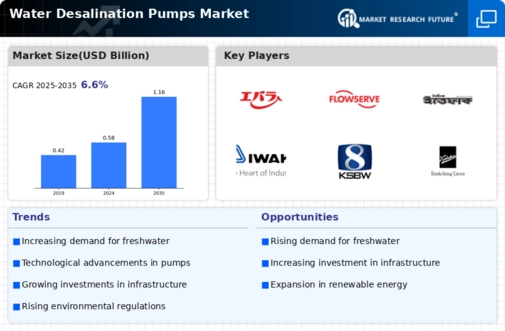Market Analysis
In-depth Analysis of Water Desalination Pumps Market Industry Landscape
The Water Desalination Pumps Market is influenced by a myriad of market factors that collectively shape its dynamics and growth trajectory. One key determinant is the increasing global demand for fresh water, driven by population growth, urbanization, and industrial expansion. As traditional water sources become strained, the need for alternative solutions like desalination rises, propelling the demand for desalination pumps.
Technological advancements represent another significant market factor. Ongoing innovations in pump design and efficiency contribute to the overall performance of water desalination systems. Improved energy efficiency, reduced maintenance costs, and enhanced durability are outcomes of these advancements, making desalination pumps more attractive to end-users.
Economic considerations also play a pivotal role. The overall economic health of regions and countries directly impacts investment in water infrastructure projects, including desalination plants. Governments and private entities are more likely to allocate funds for such projects in economically stable environments, boosting the market for water desalination pumps.
Environmental factors are increasingly influential in shaping market trends. With growing concerns about the ecological impact of traditional water sources exploitation, desalination emerges as a more sustainable option. However, the environmental footprint of desalination processes, particularly energy consumption and brine disposal, remains a challenge. Innovations addressing these concerns and promoting eco-friendly desalination solutions are likely to shape the market's future.
Regulatory landscape and policies are critical determinants affecting the water desalination pumps market. Government initiatives, regulations, and incentives can significantly impact the adoption of desalination technologies. Supportive policies that encourage sustainable water management and investments in desalination infrastructure can fuel market growth, while restrictive regulations may pose challenges.
Furthermore, geopolitical factors contribute to the market's variability. Regions facing severe water scarcity due to natural factors or political instability are more inclined to invest in desalination projects. Conversely, areas with abundant freshwater resources may exhibit slower adoption rates. International collaborations and agreements on water-sharing can also influence the demand for desalination pumps across borders.
Market competition and vendor landscape are essential factors shaping the dynamics of the water desalination pumps market. The presence of established players with extensive research and development capabilities can drive innovation and set industry benchmarks. New entrants or smaller companies may focus on niche markets or offer cost-effective solutions to gain a foothold.
Public awareness and perception of desalination technologies impact market growth as well. Educating the public about the benefits and challenges of desalination can shape public opinion, influencing government policies and investment decisions. Positive public perception can lead to increased acceptance and adoption of desalination solutions, while misinformation or skepticism may hinder market growth.
In conclusion, the water desalination pumps market is a complex interplay of various factors, ranging from technological advancements and economic considerations to environmental concerns and regulatory landscapes. As the global demand for fresh water continues to rise, the market for desalination pumps is likely to evolve, driven by innovations that address challenges and promote sustainable water management solutions. The successful navigation of these market factors will be crucial for stakeholders in the water desalination industry to capitalize on emerging opportunities and contribute to addressing the world's water scarcity challenges.
















Leave a Comment